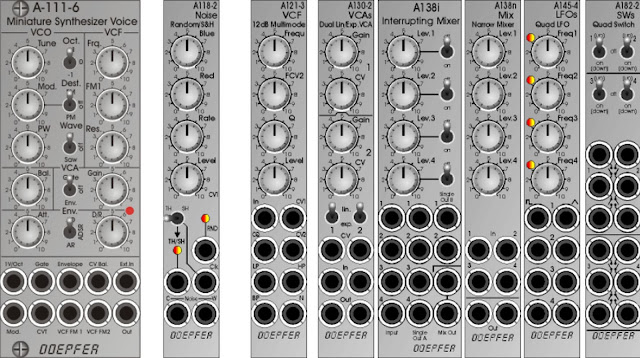 Among the brand new A-111-6 mini synth module they will show the prototypes of some planned new modules:
Among the brand new A-111-6 mini synth module they will show the prototypes of some planned new modules:Joystick module A-174-4 outputs three control voltages generated by a spring-loaded X/Y cross potentiometer (so-called joy stick) and a Gate signal.
The control voltages for X and Y are controlled by the X and Y position of the joystick in the usual way. The third control voltage Z is controlled by the rotation of the spring-loaded joystick knob.
The offset voltages which are added to the inverting outputs can be adjusted by means of three small potentiometers. That way different kinds of control voltage ranges are possible.
On top of this the four quadrant voltages Q1, Q2, Q3 and Q4 are available. A quadrant voltage becomes positive when the joystick is positioned in the quadrant in question. Each CV output is equipped with an LED that displays the present voltage
 Module A-130-8 contains eight linear voltage controlled amplifiers (VCAs). Each VCA features a control voltage input, a signal input and a signal output. In addition three mixers are included for the sum of the output signal 1-4, 5-8 and 1-8.
Module A-130-8 contains eight linear voltage controlled amplifiers (VCAs). Each VCA features a control voltage input, a signal input and a signal output. In addition three mixers are included for the sum of the output signal 1-4, 5-8 and 1-8.
 Module A-130-8 contains eight linear voltage controlled amplifiers (VCAs). Each VCA features a control voltage input, a signal input and a signal output. In addition three mixers are included for the sum of the output signal 1-4, 5-8 and 1-8.
Module A-130-8 contains eight linear voltage controlled amplifiers (VCAs). Each VCA features a control voltage input, a signal input and a signal output. In addition three mixers are included for the sum of the output signal 1-4, 5-8 and 1-8.  Typical applications • any kind of VCA application (e.g. voltage controlled attenuation of audio or control voltage signals) • two voltage controlled mixers with four channels each • voltage controlled stereo mixer with four channels each, for this the control voltage inputs have to be correspondingly patched or internally normalled: CV1=CV5 /CV 2=CV6 / CV3=CV7 / CV4=CV8 • voltage controlled mixer with eight channels • add-on for the planned Joystick module A-174-4
Typical applications • any kind of VCA application (e.g. voltage controlled attenuation of audio or control voltage signals) • two voltage controlled mixers with four channels each • voltage controlled stereo mixer with four channels each, for this the control voltage inputs have to be correspondingly patched or internally normalled: CV1=CV5 /CV 2=CV6 / CV3=CV7 / CV4=CV8 • voltage controlled mixer with eight channels • add-on for the planned Joystick module A-174-4A-133-2 Dual VC VCA/Polarizer/Inverter/Ring Modulator is the slim version of the A-133 but has some additional features and improvements available compared to the A-133.
Module A-133-2 can be used for many applications: e.g. VCA, VC polarizer/attuverter, VC inverter or ring modulator. The module contains special VCAs that allow both positive and negative amplification.
The overall amplification is defined by the sum of the voltage generated by the Man control, the external control voltage CV and the position of the CV control which works as an attenuator for the external control voltage.
By means of the external control voltage CV the manually adjusted amplification can be modulated. CV can be both positive or negative to obtain positive or negative amplification values.
In addition the CV signal can be modulated via the modulation control input Mod by means of another control voltage. '
Module A-183-4 is a fourfold level shifter.
A level shifter is required if the level of a digital control signal has to be increased or decreased. A typical application is the conversion of a gate, trigger or clock signal with +5V voltage level to +12 level.
The output level can be set by means of a jumper to +12V or +5V. The four output signals are displayed by means of LEDs. The outputs and inputs are normalled: the output signal of the upper unit is used as input signal of the unit below provided that no patch cable is inserted into the input socket of the lower unit. That way the module can be used also as clock/trigger/gate buffer or buffered multiple for digital signals. For this the signal that has to be buffered is connected to input 1. The buffered (and possible level shifted) signal appears then at all four outputs. Input voltages below +0,8 V are treated as "low", voltages above +3 V as "high"
Typical applications • Converting the levels of digital control signals (e.g. gate, trigger, clock) to another voltage level (+12V or +5V) • buffering and duplicating digital control signals (e.g. gate, trigger, clock)
It is not yet certain if the module will be manufactured in the 2 HP or 4 HP version (probably 2 HP).
Release dates: spring 2020 (without obligation)
Source: http://www.doepfer.de/home_e.htm, and their NAMM brochure (PDF)





